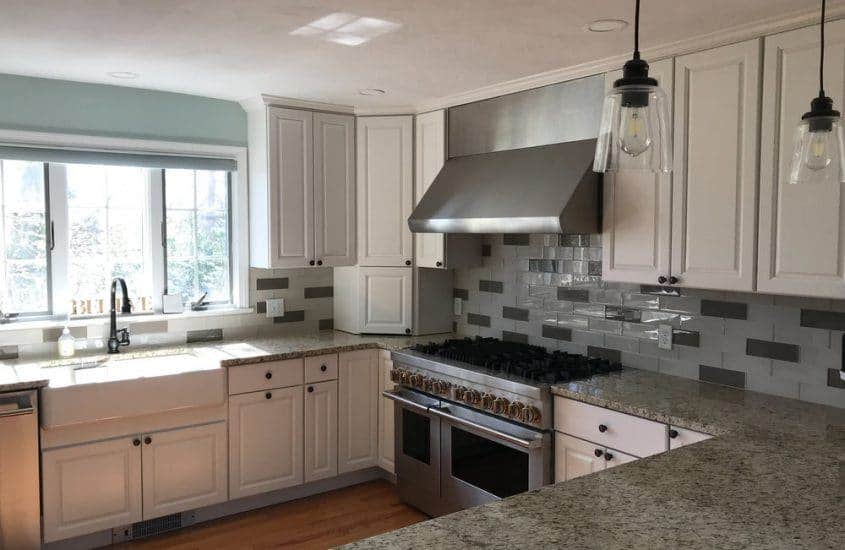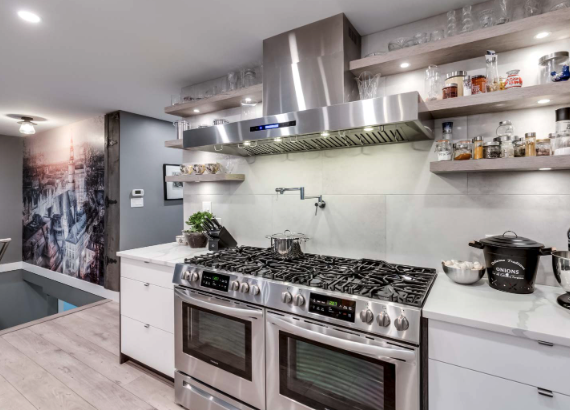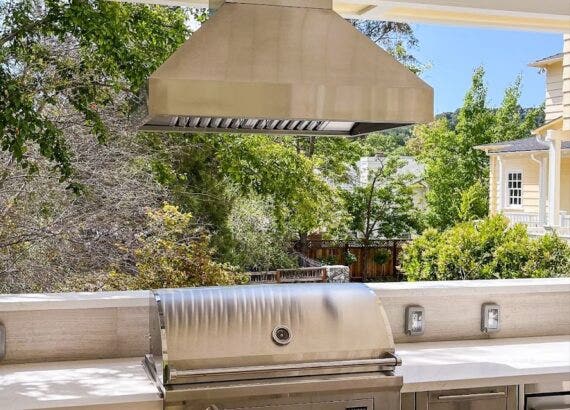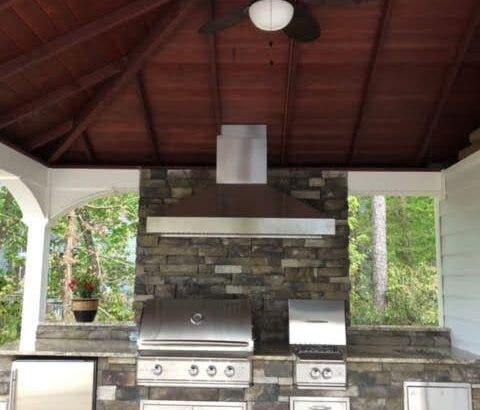7 Things to Consider When Buying a Range Hood

Are you thinking about buying a range hood for your kitchen? From range hood size, CFM, and ductwork to your cooking habits and personal preferences, there’s a lot to consider.
You’ll find all the answers you need right here. Here are seven of the most important things to consider when buying a range hood.
Table of Contents
1. Know Your Kitchen
Where is your kitchen range?
The type of hood you need depends largely on where you installed your kitchen range.
You have several options when it comes to the type of range hood you need. Yes, it might seem pretty basic once we review it, but here we go.
If your range is against a wall, you’ll want a wall mount range hood. If it’s under cabinets, you’ll want an under cabinet range hood.
Ranges on a kitchen island are also popular. For these, you’ll want an island range hood.
If you have custom cabinetry or a custom hood over your range, you’ll want a range hood insert.
Lastly, if your kitchen range is outside, you’ll want an outdoor range hood.
You also have professional hoods and artisan hoods. Professional hoods are kitchen fans that move 900 or more CFM, while artisan hoods are custom built for your kitchen. Most custom and professional models are wall and island hoods.
To learn more about the different types of range hoods that you can choose from, click here.
What is the height of your ceiling?
Depending on the height of your ceiling, you may need a range hood that comes with chimney extensions. A chimney extension is an additional accessory for your range hood that covers your ductwork.
Most wall and island range hoods come with chimneys made for standard 8’ and 9’ ceilings. But, if you have a particularly tall ceiling, you will likely need a chimney extension.
To learn more about chimney extensions, check out this guide.
Do you have room to mount the hood?
The best practice is to mount your indoor hood between 28 and 36 inches away from the cooktop. Make sure you have the room in your kitchen to fit this requirement.
For an outdoor kitchen, you need the room to mount your hood between 36 and 42” away from the surface of the cooktop. This ensures that your hood can vent the heavy grease and smoke coming from your grill effectively.
To learn more about mounting your range hood, check out our range hood mounting guide.
Is this hood for an indoor or outdoor kitchen?
Professional outdoor hoods are made of durable, weather-resistant, stain-resistant materials. These hoods can handle the elements and the intense heat of your stainless steel grill. So, if you’re remodeling or building an outdoor kitchen, it’s important to find a hood with the right materials.
Proline’s outdoor hoods are built with a durable 304 stainless steel . It’s heat resistant and weather-resistant, so it can last for years outdoors. Our indoor hoods feature 430 stainless steel, which is not suitable for outdoor kitchens.
To learn more about outdoor range hoods, check out our article ‘Why do I need an outdoor range hood?’
Or, if you’re interested in browsing some of our best outdoor hoods, click here.
2. Range Hood CFM
It’s important to get your range hood CFM right. We want you to be satisfied with your range hood. But, if you make a purchase and find out the hood doesn’t have enough power, you will be disappointed.
Generally, it doesn’t hurt to buy a range hood with a higher CFM than you think you’ll need – especially because you can’t increase your hood’s CFM after your purchase.
Here are a few things to consider to find the right CFM for you.
How large is your cooktop?
In general, the larger your cooktop, the more powerful it will be. The more powerful the range (measured in BTUs), the more CFM you need for your range hood.
Also, the larger your cooktop, the larger the hood you’ll need. We’ll discuss this more a little later.
How often do you cook? Do you like to cook Asian food, greasy food, or fried food?
It’s important to think about all your cooking habits before you buy a range hood. Specifically, how often do you cook – and what do you like to cook? Frequent cooks who love Asian cooking and fried food will need a higher CFM range hood. On the other hand, those who cook a few times a week will want a less powerful hood.
If you love Asian food, you’ll love this article ‘Best Range Hood for Asian Cooking.’
To learn more about range hood CFM, check out this complete guide.
How powerful is your cooktop? Is it gas or electric?
Gas ranges are measured in British Thermal Units, or BTUs. Electric ranges are measured in watts. Typically, you want a more powerful hood for a gas stove compared to an electric stove.
For your gas range, simply divide the total number of BTUs by 100 to get the minimum CFM for your hood.
Here is a typical example of how to size your range hood over a gas cooktop. Say the cooktop is 48” with six burners and a griddle. The small burners are 8,000 BTUs and the large burners are 12,000 BTUs. You have three of each for a total burner output of 60,000 BTUs. The griddle uses 20,000 BTUs.
The total BTUs for the cooktop is 80,000. Using our rule above of 100 CFM for every 10,000 BTUs, you would need a minimum power of 800 CFM.
For an electric range, you don’t even need the watts. Just take the width of your range and multiply it by 10 for the minimum CFM of your hood.
To learn more about calculating range hood CFM, click here.
Or to check out some of our best range hoods for gas stoves, click here.
3. Range Hood Size
For indoor kitchens, we recommend sizing your hood three inches larger than your range on each side. The added coverage helps gather all the smoke and fumes produced from your cooking effectively.
For outdoor kitchens, size your hood at least six inches larger than your range on each side. So, for example, if you have a 36” grill, your hood should be at least 48”.
To learn more about range hood size, check out this article.
4. Noise Level
The noise level of your hood, measured in sones, might be a determining factor for you. Do you prefer power over noise or vice versa? It is somewhat of a trade-off, but a quality range hood, even a powerful one, shouldn’t be unbearably loud.
Are you particular about the exact decibels you want out of your range hood? Check out this article on sones versus decibels.
One thing our customers love to do is to run their range hood on lower speeds. There are a few other ways you can make your range hood quieter, too. Check them out here.
Remember, quality matters. Low CFM doesn’t always mean low noise – you want a hood with an efficient motor too. For example, a 1000 CFM hood could have a quieter motor than a 600 CFM hood. It depends on the quality of the materials and manufacturing process used. Keep this in mind when shopping.
5. Exhaust Type – Vented & Non-Vented
There are two ways that you can set up the ventilation system on your range hood: a vented, or ducted system and a non-vented, or ductless system. The vented system uses ducting to channel the air away from the kitchen and out of the home.
With vented range hoods, you have a few venting options.
Venting Options
You can either vent your hood horizontally or vertically. Island hoods have to be vented vertically. But, wall and under cabinet hoods can be vented horizontally through a wall or vertically through the ceiling.
To learn about how to vent your hood through an interior wall, click here.
Or, vent your range hood through the ceiling with this guide.
Unlike a vented system, non-vented systems use no ductwork. The hood sucks air through charcoal filters and then recirculates it back into your home. You can use a recirculating kit or charcoal filters for this type of hood, depending on the specific model.
Ductless or recirculating hoods aren’t as effective at removing fumes and smells from your home, but can be a great option if you live in an apartment where you can’t install ductwork.
Check out some of the best range hoods for your apartment at this link.
6. Installation Time and Cost
Beyond the hood itself, you’ll want to learn how to install the hood or how much it will cost.
Most homeowners can DIY the installation. We have several instructional videos on our website that may be helpful for you.
You can also check out our installation guide.
Browse our blog for more helpful articles with videos on how to install range hoods and range hood inserts. We have several articles to help you.
7. Budget
No matter how much research you do, you can’t buy the hood if you don’t have the budget.
What exactly goes into the budget? Here are a few things:
Quality – Generally speaking, higher quality range hoods cost more than lower quality ones. This is because of better materials and more efficient motors, among othervvvvvv features.
Pro tip: If you buy directly from the manufacturer, like Proline, you can save hundreds of dollars of markup that department stores add to the price.)
Material – Outdoor hoods are more expensive, due to the durable, weather-resistant material.
Size – The larger the hood, the more expensive it will be.
Power – The more power your hood has, the more expensive it will be.
Type of Hood – Typically, island range hoods and outdoor hoods are more expensive than walls and under cabinets. Under cabinet hoods are often the least expensive model.
It is worth it in the long run to buy a more expensive, higher quality hood. You won’t have to spend as much extra money on replacement parts down the line.
Not to mention that a low quality hood could break down after a few years. Then you’ll have to buy a new hood – and that won’t be friendly to your wallet.
Installation Cost – Most homeowners can DIY the installation. But do not forget to factor in the cost of installation if you plan on having a professional do the job.
This wraps up our guide on seven things to consider when selecting a range hood. Remember, here’s the list:
- Your Kitchen Layout
- Range Hood CFM
- Range Hood Size
- Noise Level
- Exhaust Type – Vented or Non-Vented
- Installation Time and Cost
- Budget
Did this article help you find the right hood for you? If you still have doubts, check out ‘Do I need a range hood?’ for more information. Or, take a look at the articles below. Thanks for reading!
Related Articles
Should I purchase a microwave hood or a vent hood?







Comments are closed.